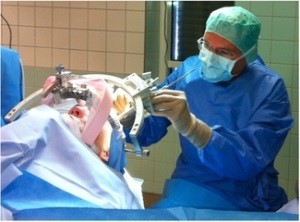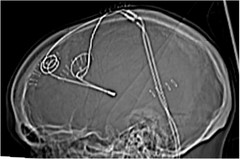Vagus nerve stimulator

Should the medication treatment be ineffective or induce considerable side-effects then treatment with vagus nerve stimulation is considered. The precondition for this is that epilepsy surgery is not possible. The effectiveness of vagus stimulation is comparable to the use of other medications with however the advantage of a more favourable profile of side-effects.
What does a vagus nerve stimulator look like?
A vagus nerve stimulator ("Neurocybernetic Prosthesis" (NCP) – from the firm Cyberonics, Texas, USA) is a device consisting of a battery-powered pulse generator (5 cm diameter, 1 cm thick) and a cable with platin electrodes. It is implanted under the left collarbone and the electrodes are connected to the left vagus nerve, that is, the 10th cranial nerve, in the neck.
How is a vagus nerve stimulator implanted?
In contrast to epilepsy surgery, this is not an operation on the brain in the same sense. The vagus nerve stimulator is surgically implanted under general anaesthesia, an operation that takes around 1 to 11/2 hours. Two small incisions are made to the left armpit and to the left of the neck in order to bring the pulse generator and the electrodes into the correct the position. The functional operation of the stimulator is tested during the operation. A long hospital stay is not normally necessary after the operation.
How does the stimulation work?

